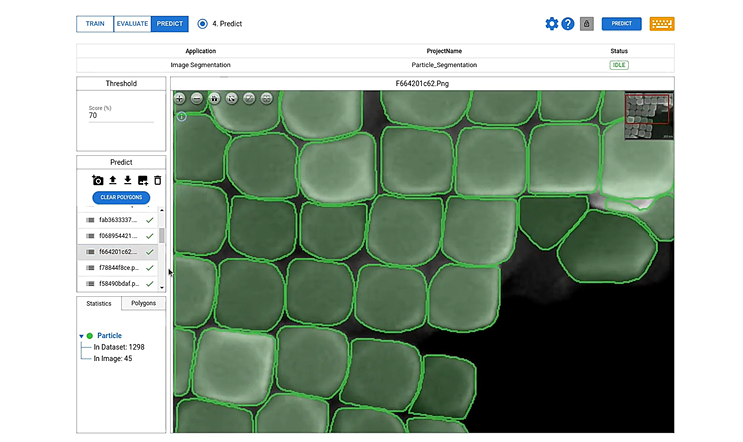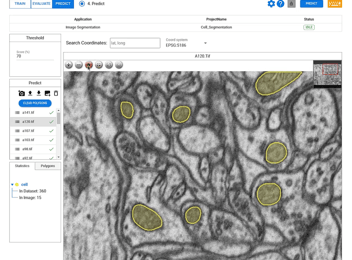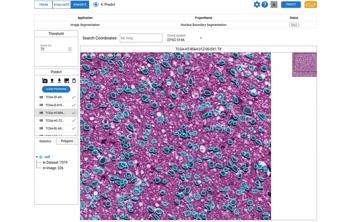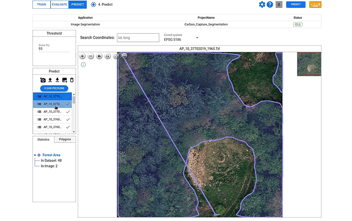Particle Segmentation in Electron Microscopy: Revealing the Unseen

Explore the importance of particle segmentation in various scientific fields and learn about the advancements in automated segmentation techniques.
Meet our latest particle segmentation model in electron microscopy. Check out the video for more details.
If you want to try this model, please visit this link.
The Importance of Particle Segmentation in Electron Microscopy
Particle segmentation plays a crucial role in electron microscopy as it allows us to uncover hidden details at the nanoscale level. By segmenting particles, we are able to distinguish different components within a sample and analyze their characteristics. This is particularly important in fields such as materials science, biology, and nanotechnology, where understanding the composition and structure of particles is essential for advancing research and development.
Moreover, particle segmentation enables us to study the interactions between particles and their surrounding environment. By accurately identifying and separating individual particles, we can investigate their behavior, such as aggregation or dispersion, and gain insights into their properties and functions. This information can then be used to improve various applications, ranging from drug delivery systems to catalysts.
Furthermore, this advanced technology plays a crucial role in maintaining consistent particle sizes and ensuring the uniform composition of nano materials. Moreover, it serves as a valuable tool in identifying and detecting even the smallest impurities present.
In summary, particle segmentation in electron microscopy is of great significance as it allows us to explore the unseen world of particles and uncover valuable information that can impact numerous scientific disciplines.
Understanding the Basics of Electron Microscopy
Before diving into the details of particle segmentation, it is important to have a basic understanding of electron microscopy. Electron microscopy is a powerful imaging technique that uses a beam of accelerated electrons to visualize samples at extremely high magnifications.
Unlike traditional light microscopes, electron microscopes have much higher resolution capabilities, allowing us to see objects and structures at the nanoscale level. This increased resolution is achieved by using electromagnetic lenses to focus the electron beam onto the sample, which then interacts with the atoms or molecules within the material.
Electron microscopy can provide valuable information about the size, shape, and composition of particles, enabling researchers to delve deeper into their properties. By combining electron microscopy with particle segmentation techniques, we can extract even more detailed information and gain a comprehensive understanding of the particles under study.
Applications of Particle Segmentation in Various Fields
Particle segmentation has a wide range of applications across various scientific disciplines. In materials science, it is used to analyze the microstructure of materials and identify different phases or defects within a sample. This information is crucial for understanding the mechanical, electrical, and thermal properties of materials, and for designing new materials with enhanced performance.
In biology and medicine, particle segmentation is employed to study cellular structures, such as organelles or nanoparticles, and investigate their functions and interactions. This is particularly valuable in cancer research, where understanding the behavior of cancer cells and their response to treatments can aid in the development of more effective therapies.
Particle segmentation also finds applications in environmental science, where it is used to analyze particulate matter in air or water samples. By accurately quantifying and characterizing particles, researchers can assess pollution levels, identify sources of contamination, and evaluate the potential health risks associated with exposure.
These are just a few examples of the diverse applications of particle segmentation in various fields. As technology continues to advance, we can expect even more exciting discoveries and innovative uses for this powerful technique.
Automated Particle Segmentation
Traditionally, particle segmentation was a time-consuming and labor-intensive process, often requiring manual intervention. However, with the advent of automated segmentation techniques, this task has become significantly more efficient and accurate.
Automated particle segmentation involves the use of advanced algorithms and machine learning models to automatically detect and segment particles in electron microscopy images. These algorithms are trained on large datasets, allowing them to learn patterns and features that distinguish particles from the background or other structures.
One notable example of automated particle segmentation is DeepBlock.net, a deep learning-based platform specifically designed for particle analysis in electron microscopy. DeepBlock.net utilizes various modern deep learning models to achieve high accuracy in particle detection and segmentation. It has been successfully applied in various research areas, such as nanomaterial characterization, drug discovery, and environmental monitoring.
The automation of particle segmentation not only saves time and effort but also enables researchers to analyze larger datasets and extract more comprehensive information. This has opened up new possibilities for scientific exploration and accelerated the pace of discovery in electron microscopy.
DeepBlock.net and Automated Particle Segmentation
DeepBlock.net is a cutting-edge platform that combines the power of deep learning and automated segmentation techniques to revolutionize particle analysis in electron microscopy.
By leveraging neural networks, DeepBlock.net can accurately detect and segment particles in complex electron microscopy images. Its advanced algorithms are trained on diverse datasets, enabling it to handle various particle types, sizes, and shapes.
In addition to particle segmentation, DeepBlock.net offers a range of powerful features, including particle counting, size distribution analysis, and particle tracking. These capabilities provide researchers with a comprehensive toolkit for studying particles and their behavior in different scenarios.
With its user-friendly interface and efficient processing, DeepBlock.net has become a valuable tool for researchers in academia, industry, and government agencies. It has contributed to numerous scientific breakthroughs and continues to drive innovation in the field of electron microscopy.
Challenges and Future Developments in Particle Segmentation
While automated particle segmentation has greatly improved the efficiency and accuracy of the process, there are still challenges that need to be addressed. One major challenge is the segmentation of complex or overlapping particles, which can be difficult to accurately separate using current algorithms.
Another area of research is the development of real-time segmentation algorithms that can process images in a fraction of the time compared to current methods. This would greatly enhance the usability of particle segmentation in various applications, such as live imaging or quality control in manufacturing processes.
Furthermore, the integration of particle segmentation with other imaging techniques, such as spectroscopy or tomography, holds great potential for obtaining more comprehensive information about particles and their properties. This multidimensional approach can provide a deeper understanding of the characteristics and behavior of particles, opening up new avenues for scientific exploration.
In conclusion, particle segmentation in electron microscopy is a dynamic field with ongoing advancements and exciting prospects. As technology continues to evolve, we can expect more sophisticated algorithms, faster processing times, and a deeper understanding of particles at the nanoscale level.





